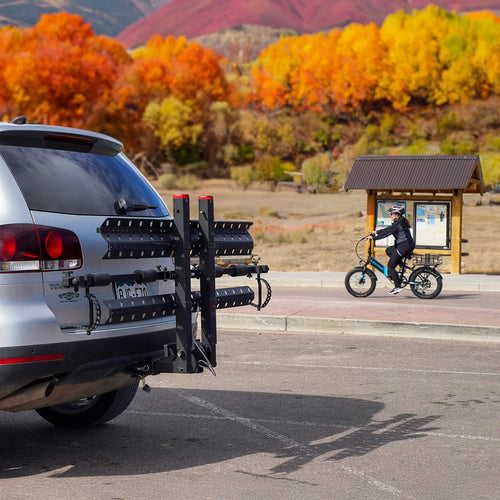Author: Amanda Kennedy
Published: January 08, 2025
Updated: January 20, 2025


E-bikes are transforming the way we commute and explore, combining the thrill of cycling with the convenience of motorized assistance. However, transporting an e-bike poses unique challenges compared to regular bicycles. Their added weight and bulk make proper transportation essential to avoid damage and ensure safety Whether you’re heading to the mountains or shipping your e-bike cross-country, this guide explores the best transport methods to keep your ride secure and ready for action.
E-bikes represent a significant financial investment. Bike frame scratches, battery damage, or drivetrain misalignment during transport can lead to costly repairs. Proper transportation ensures your e-bike stays in peak condition.
Securing your e-bike isn’t just about protecting the bike; it’s also about ensuring the safety of your vehicle, passengers, and other road users. Improper mounting or unsecured bikes can create dangerous situations on the road.
Electric bikes are often heavier than traditional bicycles, with many models exceeding 80 lbs. Ensure your chosen transport method can handle the weight and size to avoid accidents or fines.

Transporting an e-bike can be done in several ways, each with its own advantages and limitations, depending on your needs and budget. E-bikes are incredibly diverse, with variations in size, weight, and design. This diversity becomes even more pronounced with unique styles like trikes or recumbent e-bikes, which often require specialized transportation solutions. These unique designs offer unparalleled comfort and stability but may pose additional challenges for standard transport methods. Fortunately, some options are versatile enough to accommodate these specialized e-bikes, ensuring a secure and convenient ride for every style.
Bike racks are one of the most popular choices for transporting e-bikes due to their versatility and ease of use. They are designed specifically to secure bikes during transit and can accommodate various vehicle types.
Pros:
Cons:
|
|
||
| Part Number | #B02615 | #B02394 |
| Max # of Bikes | 2 Standard & Fat E-Bikes | 2 Heavy-Bulky E-Bikes |
| Max Bike Weight | 60 lbs per bicycle | 80 lbs per bicycle |
| Carrier Weight | 80 lbs | 85 lbs |
| Minimum Wheel Size | 22in | 20 |
| Maximum Bike Length | 72in | N/A |
| Maximum Wheel Base | N/A | 56in |
| Maximum Tire Size | 4in | 4.5in |
| Slideout Function | ✓ Yes | ✓ Yes |
| Fold Function | ✗ No | ✓ Yes |
| Ramp Included | ✗ No | ✓ Yes |
| Bike Lock Included | ✓ Yes | ✓ Yes |
| Receiver Lock Included | ✓ Yes | ✓ Yes |
| Supports Bike Accessories (cargo racks & baskets) |
May Not Fit | ✓ Yes |
| Minimum Hitch Rating | 2in hitch receiver, Class II | 2in hitch receiver, Class II |
| RV Trailer Approved | ✓ Yes | ✓ Yes |
Enclosed cargo carriers provide a weatherproof and secure solution for bike transport, especially for long-distance travel or when additional protection is necessary. The extra carrying capacity means you also have room for other outdoor and travel gear.
Pros:
Cons:
Tips for Success:

Transporting your e-bike inside your car can be a practical solution for larger vehicles or when external racks aren’t an option. This method offers maximum protection from weather and theft.
Pros:
Cons:
Tips for Success:

For those who need to transport multiple electric bikes or carry additional gear, a trailer or utility hitch is an excellent option. This method provides ample space and high weight capacities, making it ideal for long-distance travel or group outings.
Pros:
Cons:
Tips for Success:

|
Let's Go Aero Trailers Let’s Go Aero trailers provide a versatile and secure solution for transporting e-bikes, offering ample space to protect your bikes from the elements during travel. With durable construction and compatibility with a variety of towing vehicles, these trailers ensure your e-bikes arrive safely, whether you're heading to the trailhead or an epic adventure. |

E-bikes require sturdy racks that can handle their weight and secure them during transit. Standard bike racks often lack the features necessary to safely transport heavier e-bikes. They may not have adequate weight capacities or the proper mechanisms to keep the bike stable during transport, increasing the risk of damage or accidents. If your going to choose an exterior rack as your preferred method of transportation, investing in a rack specifically designed for e-bikes ensures safer and more efficient transportation:


Is It Okay to Lay an Electric Bike on Its Side? Laying an electric bicycle on its side can damage the battery or drivetrain. If necessary, use padding and remove the battery first.
How Do You Transport an E-Bike on a Car? Secure your e-bike with a rack designed for its weight and size. Follow these steps:
Will UPS Ship an E-Bike? Yes, but shipping e-bikes requires special preparation due to lithium-ion battery restrictions. Remove the battery and pack the bike securely in a sturdy box, using padding to prevent damage.
E-bike transport doesn’t have to be complicated. By understanding your options and investing in the right equipment, you can ensure your e-bike travels safely wherever you go. Consider your needs—frequency of use, budget, and travel distance—and choose a method that prioritizes convenience and safety. Let’s Go Aero’s e-bike carriers provide a reliable, efficient solution for all your transportation needs.